
|
The following article is for use on Ruthenian Empire historic pages only. DO NOT delete this template or the pages that use it...
Please do not edit or alter this article in any way while this template is active. All unauthorized edits may be reverted on the author discretion. |
| Empire of Kormenia Korimikí Af̱tokratoría | |||||
| 1901-2588 | |||||
| |||||
| Official language | Hellenic, Kormenian, Slavin | ||||
| Demonym | Kormenian | ||||
| Capital | Beretea | ||||
| Largest city | Beretea | ||||
| Government | Absolute Monarchy | ||||
| King | Emmanuel I (1902) (First) Thomas II (2588) (Last) | ||||
| Legislature | Ekklisia tou Laou | ||||
| Religion | Orthodox Church | ||||
| Currency | Hiperpyron | ||||
| History | |||||
| - Succession Crisis | 18th Century | ||||
| - Elevation to Empire | 1902 | ||||
| - Great War | 2120 | ||||
| - Fall of Beretea | 2588 | ||||
| |||||
The Empire of Kormenia (1901-2588) was a multi ethnic empire based in Eridana Continent in the region of Bandria Granda in the planet of White Giant, the Kormenian Empire was considered the protector of the Orthodox Church during the Late Kormenian Age and contributed to the colonization and expansion of the Selloi/Ruthene culture around the region. his numerous colonies and coastal cities around the region attracted numerous foreigners along enemies, like the Parsians, the constant rivalries between nobles houses and ater centuries were characterized by conflicts with the Parsians, who sacked Beretea in 2588, and internal warfare among Kormenia's nobility. Various powerful nobles emerged in the time period,caused after a prolonged and long war against Sultanate of Parsia the fall of the Empire after the Fall of Beretea since then, the Ruthene population was considered a minor citizen or slave and the Orthodoxy was forbidden in the peninsula during 700 years.
Some surviving noble families escaped to the borders or Arcadia and secured the "de iure" position of the Selloi of the peninsula.
History[]
The Golden Age[]
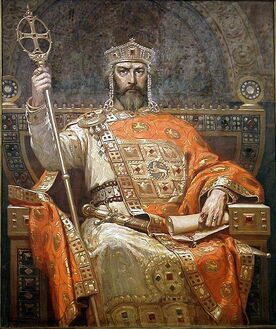
Emmanuel I, first Emperor of Kormenia
Kormenia was installed as a Empire after the Battle of Dadgori between Kormenia and Arcadia, when Emmanuel I defeat the Arcadian army and proclaimed himself as new Emperor of the Korimis, being the significance of the emperor as the "unification of all orthodox people in one sole rule guided by god" and the emperor was choosen and blessed by the patriarch to rule the faithful people of the peninsula, Emmanuel was the first Emperor of Kormenia and between 1901 and 2008 the Kastarti dynasty ruled the Empire firmly and many advances in the respect between cultures that lived in the region, so the historians say the "golden age" of Kormenia lived between 1900 and 2000.
The Descents of Emmanuel have a prosperous empire unify thanks to the church and numerous civil reforms, but the new Korims was attacked both by old enemies as pagan tribes as rebelds they did not want to belong to the Korims administration, the good emperor can annex the enemies and make good agreements between the noble houses.
Changes were also observed in the internal structure of the Empire which was dictated by both external and internal conditions. The predominance of the small free farmers, the expansion of the military estates and the development of the system of Komietes, brought to completion developments that had started in the previous period. Changes were noted also in the sector of administration: the administration and society had become immiscibly Selloi, while the restoration of Orthodoxy after the numerous pagans movements, allowed the successful resumption of missionary action among neighboring peoples and their placement within the sphere of Kormenian cultural influence. During this period the state was geographically reduced and economically damaged, since it lost wealth-producing regions; however, it obtained greater lingual, dogmatic and cultural homogeneity.
The growth of the towns attracted people of other continents, specially from the east, when the subjects of the recently installed Sultanate of Parsia make major trade agreements with the Kormenian coastal cities, and this interest in trade appears to have further increased economic prosperity in Kormenian towns. Certainly, the Persians and others were active traders in the ports of Eridana, and they made a living out of shipping goods between various ports in the continent.
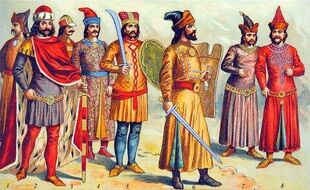
Parsian Merchants and Soldiers
The 20th and 21th centuries are said to be the Golden Age of Selloi art in Kormenia. Many of the most important Kormenian churches in and around Beretea and other important cities, for example, were built during these two centuries, and this reflects the growth of urbanisation in Kormenia during this period. There was also a revival in the mosaic art with artists showing great interest in depicting natural landscapes with wild animals and scenes from the hunt. Mosaics became more realistic and vivid, with an increased emphasis on depicting three-dimensional forms. With its love of luxury and passion for color, the art of this age delighted in the production of masterpieces that spread the fame of the kingdom throughout the continent.
Beautiful silks from the work-shops of Beretea also portrayed in dazzling color animals—lions, elephants, eagles, and griffins—confronting each other, or representing Emperors gorgeously arrayed on horseback or engaged in the chase. The eyes of many patrons were attracted and the economy of Kormenia grew. In the provinces, regional schools of Architecture began producing many distinctive styles that drew on a range of cultural influences. All this suggests that there was an increased demand for art, with more people having access to the necessary wealth to commission and pay for such work.
Yet the marvelous expansion of Selloi art during this period, one of the most remarkable facts in the history of the Kormenia, did not stop there. From the tenth to the 22th century the empire was the main source of inspiration for the other minor countries. By their style, arrangement, and iconography the mosaics of their eclesiastical style.
The last Emperor of the Kastarti was Manuel III (2002-2008) who died young by measles, and his death bring the fear of another forgotten civil war, but rapidly was solved by his cousin Andronikos Sagona, who proclaimed by the Patriarch as Andronikos VI
Feudalism and struggle[]
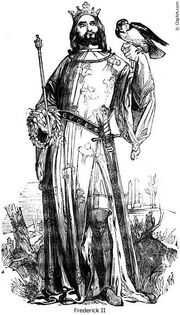
Cristophoros II attracted the Parsians to the Empire
The Kormenian Emperor introduced a variant of the feudal system. Large fiefs were granted to individuals who would defend against outside incursions, thereby creating a system for the defence of the entire state. However, in enabling the nobility to seize more and more economic and military power, the emperor itself lost influence to the noble families. During this period, the foreigners and other families adquired assets and properties in Kormenia.
The later emperors sought to restore their influence by giving certain privileges to the towns, making them Royal Boroughs or Free Royal Towns, which the emperors defended from the feudal lords in return for the town's support.
After the death of Andronikos, Karolos of Karlinia was crowned king. However, most secular lords opposed his rule and proposed the throne to his uncle Leon. The young Leon could not strengthen his position and renounced in favor of Petros, a uncle of the dead emperor, A patriarchal legate persuaded all the lords to accept Christoporos rule in 2031, but most territories remained out of royal control.
Assisted by the prelates and a growing number of lesser nobles,Petros IV launched a series of expeditions against the great lords. Taking advantage of the lack of unity among them, he defeated them one by one. He won his first victory in the battle of Lagonia in 2032. However, the most powerful lord, Matthaios of Karlinia preserved his autonomy up until his death in 2093, while the other rivalries were subjugated two years later, Christoporos was forced to attract Parsian as mercenaries to strengthen his army, this begins the Parsian attraction to the peninsula, establishing in Massalia and other eastern borders.
The Sagovian Dynasty[]
The son of Petros, Pavlos III (2034-2089), introduced a centralized power structure in the 2030s. Stating that "his words has the force of law", he never again convoked the Diet. Even his most faithful partisans depended on revenues from their temporary honours, because the emperor rarely made land grants. This practice ensured the loyalty of the noble families and foreign mercenaries to his favor and assured the imperial loyalty around the empire.
The Emperor even afforded to grant privileges which contradicted customary law. For instance, he occasionally authorized daughters of noblemen to inherit their fathers' estates, although local customs required that a deceased nobleman's inherited lands were to be transferred to his agnates in lack of a son. Nevertheless, Selloi law never replaced customary which gave rise to the appearance of lay officials who possessed "a good command of Selloi and a fair knowledge of common law"
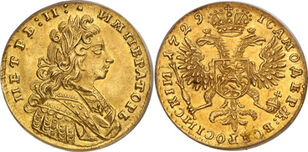
Hyperpyron
Pavlos III reformed the system of royal revenues and monopolies. For instance, he imposed the "thirtieth" (a tax on goods transferred through the Empire frontiers), and authorized landholders to retain one third of the income from mines opened in their estates. The new mines produced around 2,250 kilograms (4,960 lb) of gold and 9,000 kilograms (20,000 lb) of silver annually, which made up more than 30 percent of the world's production up until the fall of the Empire. However, most profits from the mines were transferred to Parsian and Arcadian merchants, because the value of imported fine textiles and other goods always exceeded the price of cattle and wine exported from the Empire.
Pavlos III also ordered the minting of stable golden coins modelled on the own money, called Hyperpyron and reformed the economy of the country, based in the trade and the dependency of the new currency, the measure was a success and the foreign merchants was forced to pay in hyperpyrons to make some transactions
Earlier distinctions between Selloi, Mauryan and Slavian disappeared in the 2090 because all peasants had acquired the right to free movement by the 2050s. Most of them cultivated well defined parcels with a hereditary right to use it for a rent in cash and in-kind "gifts" due to the landowner. The legal position of "true noblemen" was also standardized when the idea of "one and the same liberty" was enacted in 2100. For instance, all noblemen received the right to "adjudicate all offences committed" by the peasants living in their estates
Most towns were still dominated by Parsian Merchants, but more and more Slavian, Kormenian settlers from other cities arrive the cities and Andreas II's Privilegium pro Slavis ("Privileg for the Slavians") from 2100 was the first indication of official bilingualism in a town. It ensured that the Slavians in Terepesos have the same privileges as any other citizen.
Andreas II who was heir presumptive to Arcadian Giuliano VII and helped the Arcadians in various civil wars between them. However, his vassals often rebelled against him in the 2120. Bogdan, a Slavian voivode even achieved some autonomy.
Religious fanaticism is one of the featuring element of Andreas II's reign. He attempted, without success, to convert many of his Pagan and muslim subjects to Orthodoxy by force. He expelled the Jews around 2130, but allowed them to return in 2138.
New royal castles were erected, for instance, in various parts of the empire.
Decline and War[]
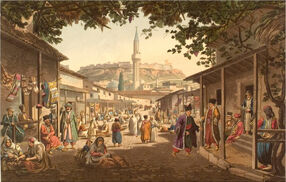
From the late year 2110, the Empire began to recover from the devastating impact of successive invasions and parsian raids, and the reconquest of old territories began. Some Mauryans fleeing from the Tiranny of the Sasso dinasty become settlers and being assimilated as part of the Kormenian culture. The Slavians were assimilated and considered as part of the empire since long time ago (thanks to the pacta conventa and the personal union between the crowns of Kormenia and Slavinia). By the middle of the 2100, and the cities began to recover due to improved security and the restoration of effective central control.
Recent research has revealed that this period was a time of significant growth in the rural economy, with rising population levels and extensive tracts of new agricultural land being brought into production. The widespread construction of new rural churches is a strong indication that prosperity was being generated even in remote areas. A steady increase in population led to a higher population density, and there is good evidence that the demographic increase was accompanied by the revival of towns. According to Enrico Poli in his book ‘’Economic expansion in the Kormenia 2000–2300’’, towns expanded significantly in this period. Archaeological evidence shows an increase in the size of urban settlements, together with a ‘notable upsurge’ in new towns. Archaeological evidence tells us that many of the medieval towns, including Menelogion, Massalia, Tortossa and Korlassis, experienced a period of rapid and sustained growth, starting in the 22th century and continuing until the end of Empire existence.
The prosperity and the situation of Beretea attracted the Parsians from the east
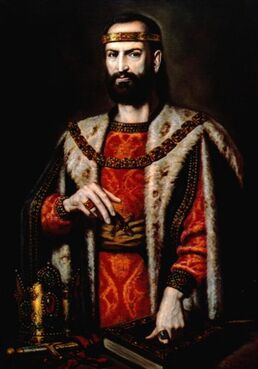
Manuel V
Manuel V (2215-2232) also know as "The Great" thanks to his rule and conquest of the southern islands and the success of the protection of Agios against pirates, in his northern borders, the Parsians conquest Thabasion and blocked the Kormenian merchant navies, the constant raids of Parsians and the menace of the new religious schism, Manuel, declared a "great war" agains Parsia in 2212, called the conflict as the Kormenian-Parsian War That war would mark the future of the empire and the history of the peninsula for the past 900 years. This war ended in 2588, 300 years later after multiple warfare which caused a massive diaspora of Selloi people and gradual weakening of the structures of the Kormenian state and the reduction of its land from Parsian invasions
Mavrodoukas Reign[]
During the Great war, The decline of the reigning dynasty was evident, Emperor Emmanuel III was considered a drunken playboy who delegated the imperial administration to its protected and general fighting in the border needed imperial support, one of his generals, Andreas, was revealed to the imperial power ecclesiastical permission and made a coup to overthrow emmanuel, the emperor was exiled to the north and was never heard from him, and was crowned as Andreas III
Andreas III Gifted with a fine physique and great personal courage, unconditionally devoted to a military career. He struggled to restore by force of arms the predominance of Kormenia in all the borders, assembled his army at the military base Lopadion and set out on a punitive expedition against Farvardin the Sultan of Parsia, who had been repeatedly violating the frontiers of the Empire in western borders. There was no attempt at a systematic conquest of territory, but Andreas's army defeated the Parsians at Acrones, before capturing and destroying the fortified town of Philomelion, removing its remaining Christian population. The Kormenian forces reached Farvarhin's capital, Konya, and ravaged the area around the city, but could not assault its walls, securing the borders and a brief peace between the countries.
His grandson, Demetrios I died during the Battle of Kollonia defending the city and the defeat of the Kormenian Army, after his death, the house of Milessinos, a cadet branch of the Mavrodoukas take the power.
The Misrule of Angelos and Decline[]
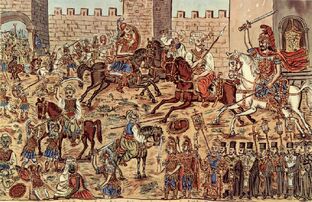
the Fall of Beretea marks the end of the Kormenian Period
the Angeloi failed to stop the invasions of the Parsians by the Sultanate of Parsia, the successful uprising and resurrection of the Parsians
A combination of incompetence and bitter infighting among the elite saw Kormenia permanently lose her financial capability and substantial military power; her previous policies of openness with foreigners, followed with the sudden massacre of parsians under the last Angelos emperor, had preceded the rule of the Angeloil making enemies among foreigner states. The weakening of the empire under the Angeloi dynasty invited the end of the Empire in 2588 under the rule of Thomas II.
The war and the Angeloi decandence was so long that wore the troops and Kormenian society to the point that they lost faith both in government and in his own empire, diasporas and numerous migrations weakened the flagging position and Persians locks precluded the arrival of new inhabitants were formed, the situation was to the point that the last Emperor of Kormenia, Thomas II said "Kormenia nothing left, only history and its treasures, people no longer believe in this empire"
In 2588 ended with the fall and destruction of Beretea and enslavement of the all Selloi people, the period of Great War decisively influenced the Imperial internal development, as elements of feudality entered aspects of Ruthene life.
See Also[]
| ||||||||||||||||||||||||||||||||||||



